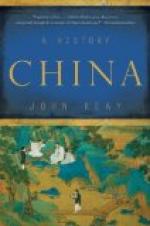In 1908 the dowager empress fell ill; she was seventy-four years old. When she felt that her end was near, she seems to have had the captive emperor Te Tsung assassinated (at 5 p.m. on November 14th); she herself died next day (November 15th, 2 p.m.): she was evidently determined that this man, whom she had ill-treated and oppressed all his life, should not regain independence. As Te Tsung had no children, she nominated on the day of her death the two-year-old prince P’u Yi as emperor (reign name Hsuean-t’ung, 1909-1911).
The fact that another child was to reign and a new regency to act for him, together with all the failures in home and foreign policy, brought further strength to the revolutionary party. The government believed that it could only maintain itself if it allowed Yuean Shih-k’ai, the commander of the modern troops, to come to power. The chief regent, however, worked against Yuean Shih-k’ai and dismissed him at the beginning of 1909; Yuean’s supporters remained at their posts. Yuean himself now entered into relations with the revolutionaries, whose centre was Canton, and whose undisputed leader was now Sun Yat-sen. At this time Sun and his supporters had already made attempts at revolution, but without success, as his following was as yet too small. It consisted mainly of young intellectuals who had been educated in Europe and America; the great mass of the Chinese people remained unconvinced: the common people could not understand the new ideals, and the middle class did not entirely trust the young intellectuals.
The state of China in 1911 was as lamentable as could be: the European states, Russia, America, and Japan regarded China as a field for their own plans, and in their calculations paid scarcely any attention to the Chinese government. Foreign capital was penetrating everywhere in the form of loans or railway and other enterprises. If it had not been for the mutual rivalries of the powers, China would long ago have been annexed by one of them. The government needed a great deal of money for the payment of the war indemnities, and for carrying out the few reforms at last decided on. In order to get money from the provinces, it had to permit the viceroys even more freedom than they already possessed. The result was a spectacle altogether resembling that of the end of the T’ang dynasty, about A.D. 900: the various governors were trying to make themselves independent. In addition to this there was the revolutionary movement in the south.
The government made some concession to the progressives, by providing the first beginnings of parliamentary rule. In 1910 a national assembly was convoked. It had a Lower House with representatives of the provinces (provincial diets were also set up), and an Upper House, in which sat representatives of the imperial house, the nobility, the gentry, and also the protectorates. The members of the Upper House were all nominated by the regent. It very soon proved that the members of the Lower House, mainly representatives of the provincial gentry, had a much more practical outlook than the routineers of Peking. Thus the Lower House grew in importance, a fact which, of course, brought grist to the mills of the revolutionary movement.




